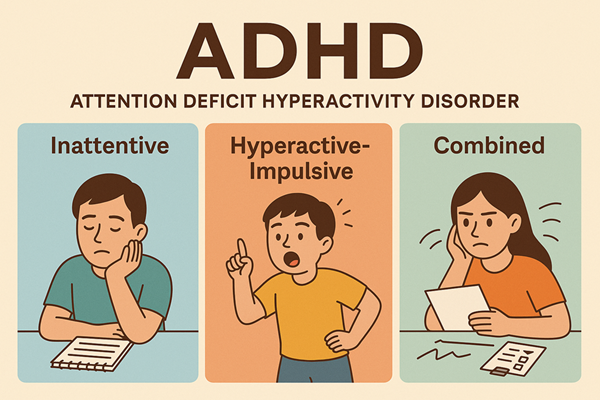
ADHD (Attention Deficit Hyperactivity Disorder) is often misrepresented, with many unaware of the various types and how they impact different individuals. Recognising the type of ADHD someone has is critical to developing effective strategies for managing symptoms and improving their daily lives. Here’s a look at the different ADHD types and how they can manifest.
ADHD is a neurological condition that affects both children and adults and impacts an individual’s ability to maintain focus, regulate behaviour, and manage impulses. The symptoms can vary significantly depending on the type of ADHD, which is why it’s essential to understand the differences. The three recognised types of ADHD are: inattentive, hyperactive-impulsive, and combined. Each type has a unique set of characteristics that influence behaviour and functioning in different environments, such as at home, school, or work.
Individuals with inattentive ADHD primarily struggle with concentration and staying focused. They might sometimes appear distracted, forgetful, or disorganised. This type of ADHD is sometimes referred to as ADD (Attention Deficit Disorder), though this term is no longer officially used in medical diagnoses. Those with inattentive ADHD may find it difficult to follow instructions, complete tasks, or remember important details.
Common signs of inattentive ADHD include:
The hyperactive-impulsive type of ADHD is characterised by behaviours such as constant movement, impulsiveness, and a lack of control over one’s actions. People with this type may feel restless, find it hard to sit still, and struggle to wait their turn. They might interrupt others in conversations and act without considering the consequences. This can be especially challenging in social or professional settings.
Common signs of hyperactive-impulsive ADHD include:
As the name suggests, combined ADHD involves a mixture of symptoms from both the inattentive and hyperactive-impulsive types. Individuals with this type face challenges in both areas; struggling to focus as well as exhibiting hyperactive and impulsive behaviours. It is the most common type of ADHD and can make everyday tasks more challenging.
Common signs of combined ADHD include:
Each type of ADHD can influence various aspects of an individual’s life. For those with the inattentive type, it can make simple tasks, like following instructions or remembering deadlines, difficult. Individuals with hyperactive-impulsive ADHD may find social interactions or sitting still for long periods to be challenging. Those with combined ADHD often face the toughest challenges, as they have to deal with symptoms from both categories.
Understanding the type of ADHD a person has is crucial for tailoring effective strategies. For example, someone with inattentive ADHD might benefit from using organisational tools like calendars or reminders, while someone with hyperactivity might benefit from using physical outlets to manage energy levels, like regular exercise.
Managing ADHD symptoms involves a range of strategies. Treatment options may include medication, therapy, and lifestyle adjustments, tailored to the specific type of ADHD. Here are some common approaches:
Understanding the different types of ADHD is key to providing the right support for individuals affected by the condition. Whether it’s the inattentive, hyperactive-impulsive, or combined type, recognising the symptoms is the first step towards improving one’s quality of life. With the appropriate management strategies in place, individuals with ADHD can lead successful, fulfilling lives.
If you’re looking for a professional ADHD assessment or ongoing support, contact ADHD Clarity today. Our team is ready to help you achieve greater clarity and confidence in managing ADHD.
© 2025 ADHD Clarity. All rights reserved.